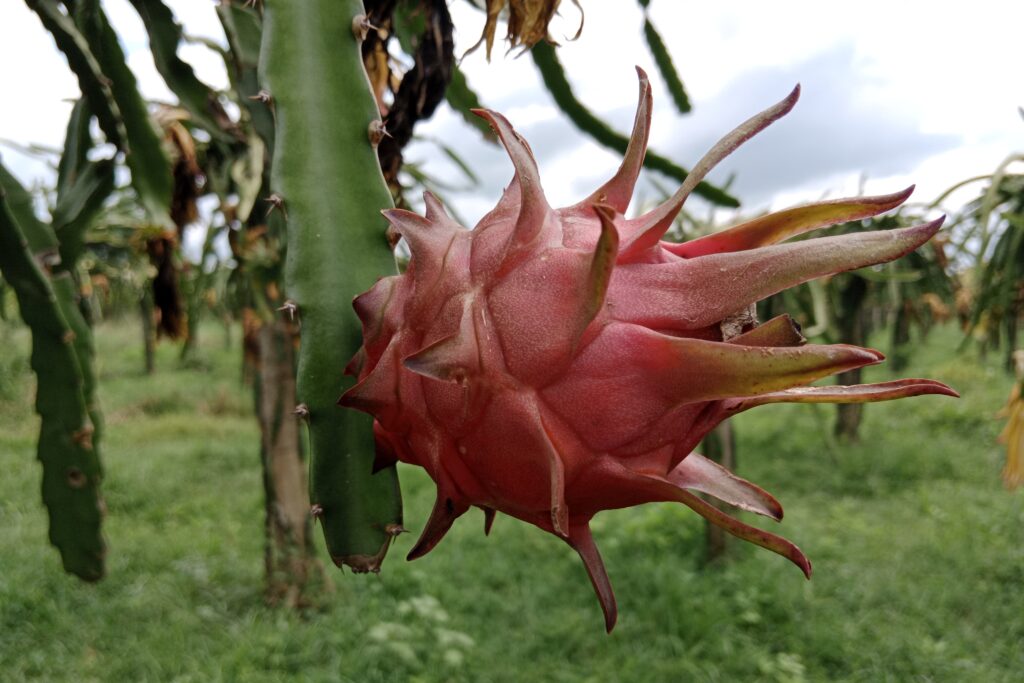Horseradish Farming
Horseradish (Armoracia rusticana) is a robust and enduring root vegetable, celebrated for its sharp, spicy taste and diverse applications in food and natural remedies. Farmers primarily grow it for its substantial, cone-shaped roots, which develop best in temperate conditions under full sun and in soil that drains well. Despite being low in calories, it is nutritionally dense, offering a good supply of vitamin C, potassium, calcium, and antioxidants, in addition to bioactive components like glucosinolates that support wellness. Its toughness, ability to store well, and health advantages establish it as a significant and reliable plant for both agricultural production and private garden plots.
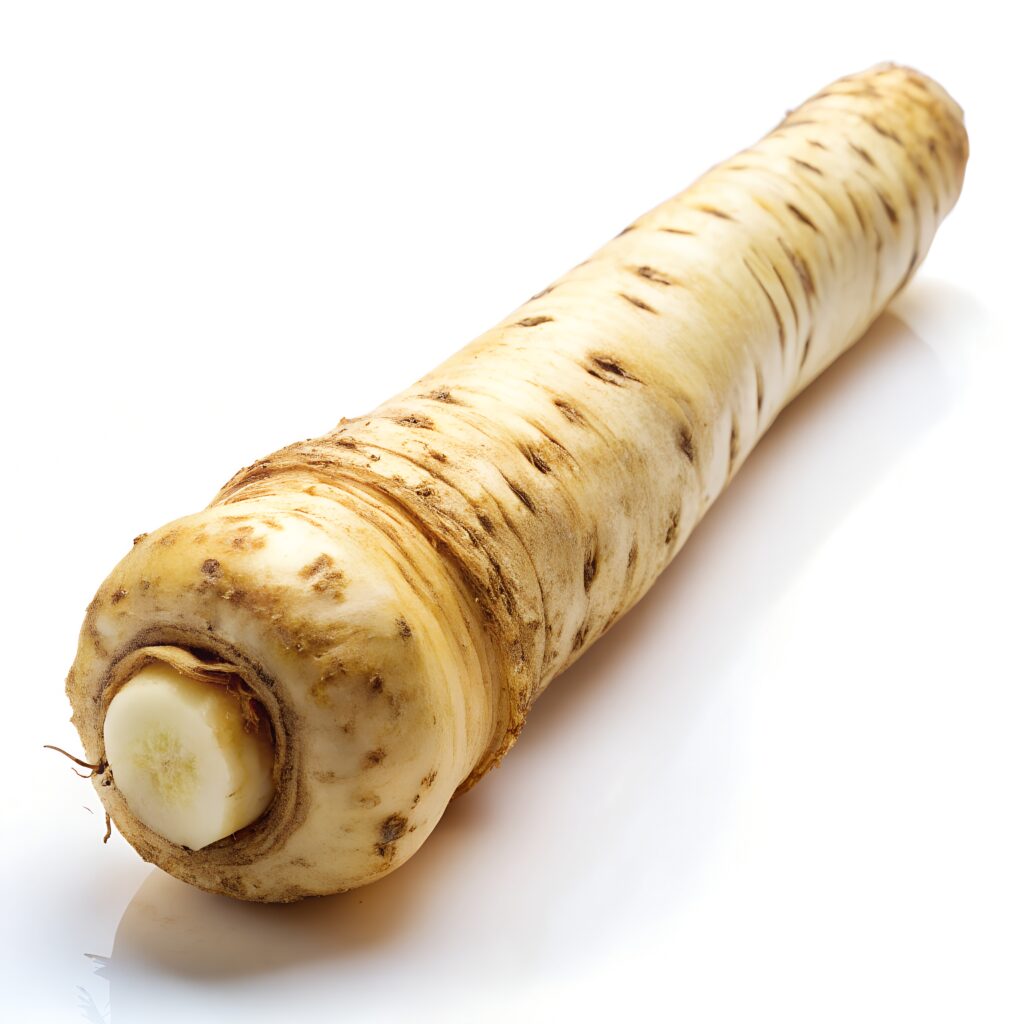
Horseradish farming profit per acre can be highly rewarding, as reflected in the financial analysis of this venture. With a total income of NRs. 135,000 against an investment cost of just NRs. 50,000, farmers can achieve a net profit of NRs. 85,000. This translates to an impressive profit margin of 62.96%, meaning nearly two-thirds of the income is pure profit. Even more striking is the return on investment (ROI) of 170%, which shows that every rupee invested generates an additional NRs. 1.70 in profit, highlighting the strong economic potential of horseradish cultivation.
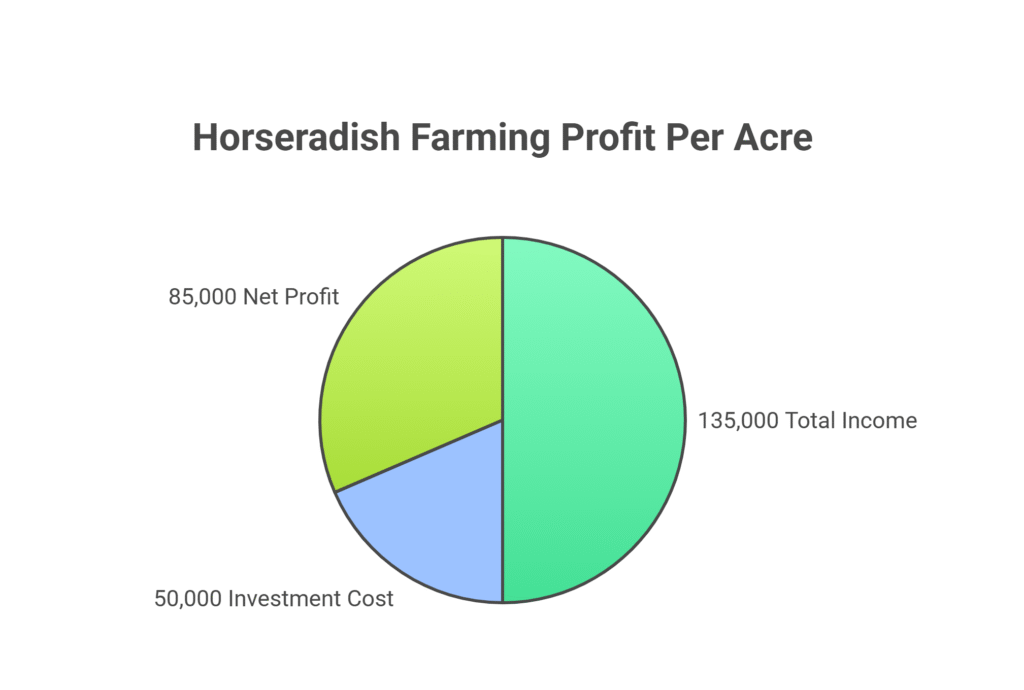
Land Preparation
Proper land preparation is essential for successful horseradish cultivation as it ensures the development of long, straight, and well-formed roots. The process begins with primary tillage, where the field is plowed deeply to a depth of 12–18 inches (30–45 cm) using a moldboard plow or subsoiler to break hardpans, promote easy root penetration, and improve drainage.
This is followed by secondary tillage, which involves harrowing and disking the soil 2–3 times to break clods and create a fine, loose, and well-aerated tilth. In regions with heavy rainfall, raised bed formation can further help by preventing waterlogging. Ultimately, the final seedbed should be clean and free from weeds, stones, and crop residues to provide the best growing environment for horseradish roots.
Soil Type
Horseradish thrives best in deep, well-drained sandy loam or loam soils. These soils, which are slightly acidic to neutral (pH 6.0–7.5), promote the development of straight, high-quality roots by warming quickly and allowing for easy penetration. In contrast, heavy clay soils can cause rot and deformities, while shallow or rocky soils typically produce poor, forked roots.
Climatic Requirements
Hardiness
A perennial that thrives in a variety of climates, horseradish is incredibly resilient. Because of its endurance, it can be grown in areas with cold winters because it can tolerate freezing temperatures and frost better than many other root crops.
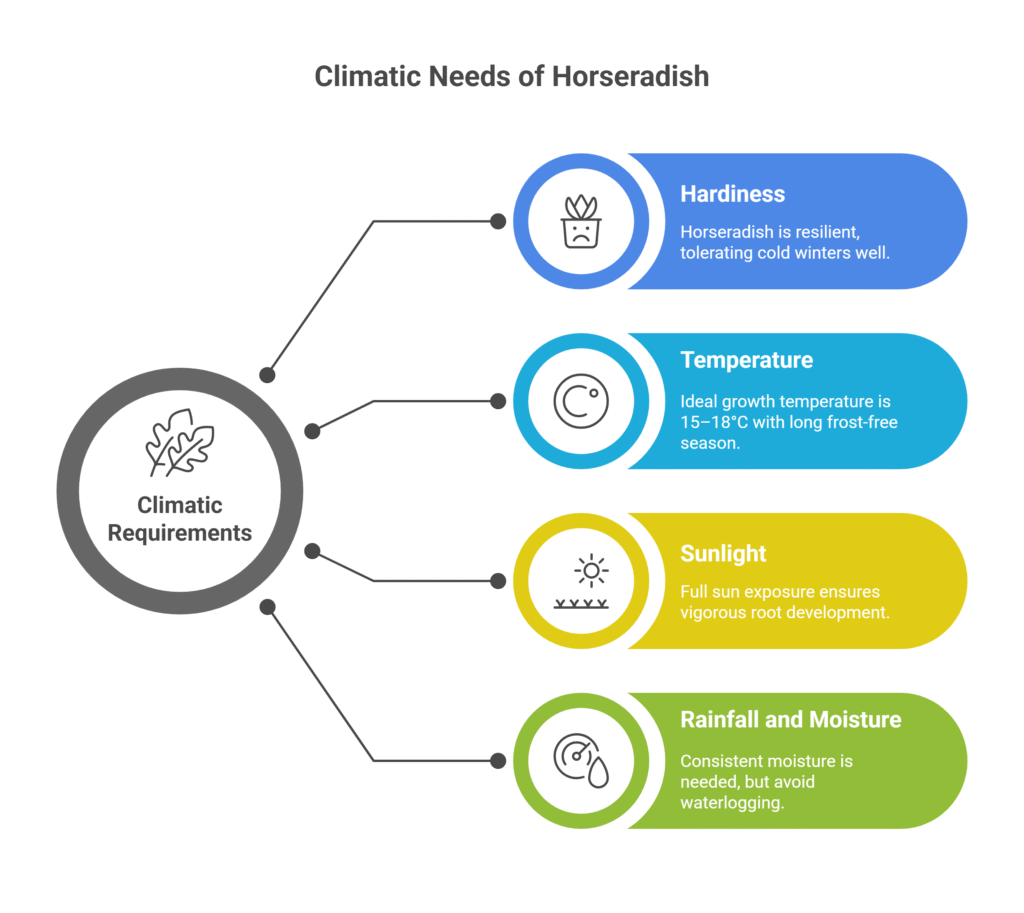
Temperature
This crop thrives in cool to moderate temperatures. The ideal temperature range for horseradish growth is between 60–65°F (15–18°C). To produce large, well-developed roots, it requires a long frost-free growing season, typically lasting about 140–160 days. Temperatures outside this range can slow growth and reduce root quality.
Sunlight
Full sun exposure is essential for horseradish cultivation. Adequate sunlight ensures vigorous leaf growth, which in turn supports the development of thick, flavorful roots. Shady conditions may result in poor root formation and reduced yields.
Rainfall and Moisture
For horseradish to thrive, the soil must be consistently moist. It’s crucial to water frequently, particularly during dry conditions. However, because too much moisture can cause root rot and other fungal diseases, the crop cannot withstand being wet. For cultivation to be successful, the soil must drain well.
Major Cultivars of Horseradish
Most commercial horseradish production relies on clonally propagated cultivars that have been carefully selected for their superior root quality and high yield, ensuring consistent performance and desirable characteristics across crops.
| Cultivar Name | Type | Key Characteristics |
| ‘Common’ / ‘Bohemian’ | Traditional | Broad, crinkled leaves; excellent root quality; more susceptible to diseases (e.g., white rust, turnip mosaic virus). |
| ‘Sass’ / ‘Swiss’ | Traditional | Narrower, smooth leaves; better disease resistance; can be considered slightly inferior in quality. |
| ‘Maliner Kren’ | European | A popular European variety known for its high quality. |
| ’15X’ / ’21B’ | Improved | Newer cultivars developed by breeding programs; offer improved disease resistance and yield. |
Propagation
Horseradish is almost exclusively propagated vegetatively using root cuttings, as seeds are rarely produced and do not breed true-to-type. Healthy, disease-free mother plants provide the source material, with lateral roots—about the thickness of a pencil (0.5 to 0.75 inches or 1.3–1.9 cm in diameter)—cut into sections 4 to 8 inches (10–20 cm) long, commonly referred to as “sets” or “slips,” which are then used for planting.
Sett Rate per Acre
Since horseradish is propagated using root cuttings, the term “seed rate” refers to the quantity of cuttings needed for planting, with approximately 10,000 to 14,000 root cuttings required per acre, which corresponds to roughly 200–300 pounds of root cuttings for one acre.
Nursery Management
A formal nursery is not typically maintained for annual production. Instead, a small “mother plot” is kept to supply the root cuttings for the next season’s main crop. This plot is managed with high fertility and monitored closely for pests and diseases to ensure the production of healthy, virus-free planting material.
Planting
a). Planting Season
The ideal planting season for horseradish is in early spring, typically from mid-February to April, ensuring optimal root establishment and growth.
b). Spacing
Rows are spaced 60 cm apart, with individual plants positioned 45 cm apart within each row, allowing sufficient space for root development and proper crop management.
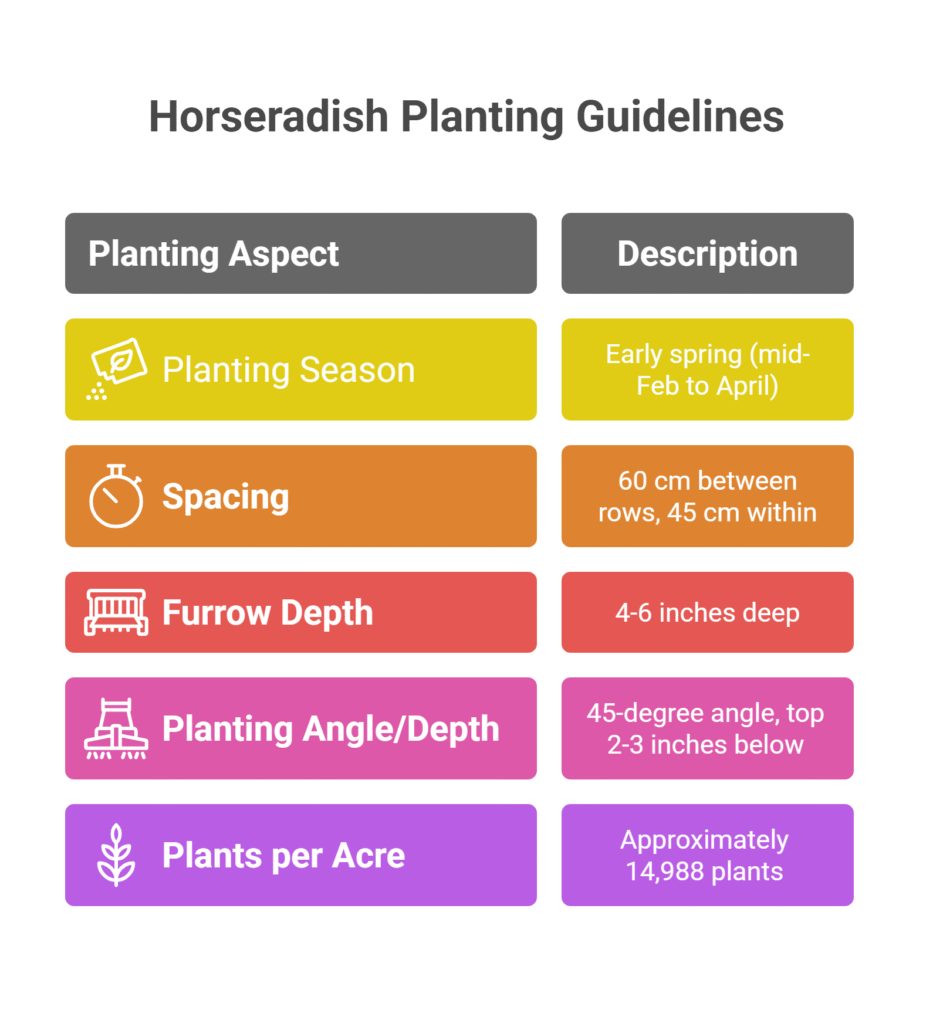
c). Furrow Preparation
Furrows for horseradish planting are prepared 4–6 inches deep along the marked rows, providing an appropriate bed for placing root cuttings and supporting proper root development.
d). Planting Method
Horseradish root cuttings are planted at a 45-degree angle, with the top (proximal) end 2–3 inches below the soil surface and the bottom (distal) end placed deeper, a technique that encourages the development of a single, straight main root and makes harvesting easier; after positioning, the furrow is covered with soil and gently firmed to hold the cuttings in place.
e). Number of Plants per Acre
Based on the specified spacing, approximately 14,988 horseradish plants can be accommodated per acre.
Intercropping
Horseradish, with its wide spacing and slow initial growth, is well-suited for intercropping with fast-maturing crops such as lettuce, radishes, or spinach, which can be harvested well before the horseradish canopy closes, providing an additional income stream without causing significant competition.
Irrigation
Critical Period
Maintaining consistent soil moisture is absolutely essential for successful horseradish growth. This is especially critical during the mid to late summer months, which coincides with the root bulking stage. The availability of adequate water during this pivotal period has a direct and significant impact on the final size and quality of the roots
Method
To achieve this optimal moisture level efficiently, drip irrigation is the highly recommended method. This system is ideal because it delivers water precisely to the root zone where it is needed most. This targeted approach not only conserves a significant amount of water but also has the added benefit of keeping the plant’s foliage dry, thereby substantially reducing the risk of foliar diseases.
Schedule
To maintain wet but not soggy conditions, irrigation should be provided whenever the top 1-2 inches of soil feel dry. To let the roots to reach full maturity and acquire their distinctive pungency, irrigation should be decreased a few weeks prior to harvest.
Horseradish Fertilizer Recommendation (Per Acre)
Conducting a soil test is essential to develop an accurate and effective fertilizer program for horseradish cultivation.
| Fertilizer Type | Recommended Application | Timing & Method |
| Organic Manure | 15-20 tons of well-decomposed FYM or compost | Basal Application: Incorporated into the soil uniformly during land preparation, before planting. |
| Biofertilizers | 800g each of Azospirillum, PSB (Phosphorus Solubilizing Bacteria), and Potash Mobilizing Bacteria | Basal Application: Incorporated into the soil uniformly during land preparation, before planting. |
| Inorganic (P & K) | 50-60 kg P₂O₅ and 80-100 kg K₂O | Basal Application: Full dose applied and incorporated into the soil at the time of planting. |
| Inorganic (N) | 80-100 kg N | Split Application: • Half the dose (40-50 kg N): Applied at the time of planting. • The remaining half (40-50 kg N): Applied as a side-dressing 6-8 weeks after planting. |
Note: N = Nitrogen, P₂O₅ = Phosphorus Pentoxide (source of Phosphorus), K₂O = Potassium Oxide (source of Potash).
Weed Control
Weeds pose a significant challenge for horseradish, particularly during the early stages of growth; they can be managed through cultural practices such as shallow hoeing and hand weeding, mechanical methods like using cultivators between rows, or chemical control with pre-emergent herbicides such as trifluralin, ensuring that all label instructions and local regulations are strictly followed.
Interculture Operation
A unique and critical interculture operation for horseradish is pruning or suckering, which addresses the plant’s natural tendency to produce many lateral roots (“suckers”) that divert energy away from the main root, resulting in a small and misshapen harvest.
The solution is a process called “suckering” or “lifting,” performed about 8-10 weeks after planting. This involves carefully pulling the soil away from the main root crown, then rubbing off or cutting all but the top one or two lateral shoots. The soil is then replaced, a technique that forces the plant’s energy into developing a single, large, and marketable primary root.
Flowering and Fruit Management
Horseradish may produce small white flowers on tall stalks if left unmanaged, but these flower stalks should be removed as soon as they appear, as flowering and seed production divert energy from root development, significantly reducing both yield and quality.
Pest and Disease Management
Common Pests
a). Flea Beetles
Small, jumping insects called flea beetles cause many tiny, shot-hole wounds on horseradish leaves, which can stunt growth and reduce crop vigor, especially in young plants.
In severe infestations, insecticide treatment may be necessary, such as Spinosad 45% SC at 0.5–1.0 ml per liter of water or Lambda-cyhalothrin 2.5% EC at 1.0–1.5 ml per liter, to ensure thorough leaf coverage. Non-chemical control methods include using floating row covers right after planting to physically block the beetles.
b). Cabbage Loopers/Imported Cabbageworms
Cabbage loopers and imported cabbageworms are caterpillars that cause significant defoliation by chewing large, irregular holes in horseradish leaves, which can severely reduce photosynthesis and hinder root development; they can be controlled biologically using the microbial insecticide Bacillus thuringiensis (Bt), applied as Bt var. kurstaki 5% WP at 1.0–1.5 grams per liter of water, or chemically with Indoxacarb 14.5% SC at 2.0–3.0 ml per liter, with applications most effective when the caterpillars are young.
c). Root Maggots
Root maggot larvae cause severe damage by tunneling into developing horseradish roots, creating entry points for rot pathogens and often rendering the roots unmarketable; chemical control is challenging once larvae are inside, so prevention is key, including applying a soil drench or granular insecticide such as Chlorpyrifos 20% EC at 1.5–2.0 liters per acre at planting to target adult flies before egg-laying, and implementing crop rotation by avoiding horseradish or other brassica crops in the same field for two to three years to disrupt the pest’s life cycle.

Common Diseases
a). White Rust (Albugo candida)
White rust is a fungal disease characterized by chalky-white, blister-like pustules on the undersides of horseradish leaves, often accompanied by yellow lesions on the upper surfaces. Severe infections can distort and kill leaves, weakening the plant and reducing root yield. Management is most effective when using an integrated approach.
Protective fungicides should be applied at the first sign of disease, with Mancozeb 75% WP recommended at 2.0–2.5 grams per liter of water, or for more systemic control, Metalaxyl 8% + Mancozeb 64% WP at 2.0–2.5 grams per liter, repeated every 7–10 days according to label directions. Long-term, sustainable control includes planting resistant cultivars such as the ‘Sass’ type and removing or destroying severely infected plant debris to reduce the source of spores.
b). Turnip Mosaic Virus (TuMV)
Turnip mosaic virus causes distinctive mosaic patterns of light and dark green on horseradish leaves, accompanied by stunting, leaf curling, and black spots. As there is no cure, prevention is the only control option. Since the virus is transmitted by aphids, managing the insect vector is crucial.
Systemic insecticides such as Imidacloprid 17.8% SL at 100–150 ml per acre as a soil drench or Acetamiprid 20% SP at 60–80 grams per acre as a foliar spray can help control aphid populations. Critical preventive measures include using certified virus-free planting stock and promptly removing and destroying infected plants to prevent virus spread to healthy crops.
c). Root Rots (e.g., Fusarium, Verticillium)
Root rots are soil-borne fungal diseases that cause wilting, yellowing, and eventual collapse of horseradish plants as the root system decays and becomes discolored, often leading to total crop loss. Chemical control is difficult, so prevention through cultural practices is key.
Preventive soil drenches at planting with Carbendazim 50% WP at 200–250 grams per acre or Thiophanate-Methyl 70% WP at 150–200 grams per acre can help protect young roots from initial infection. Non-chemical strategies include ensuring excellent field drainage to avoid waterlogged conditions, practicing long crop rotations of 3–4 years without horseradish or related brassica crops, and planting only healthy, disease-free root sets (crowns).
Harvesting
Horseradish is harvested in late autumn, after a hard frost has killed the top foliage, which converts the root’s starch into sugar and enhances its flavor and pungency; the soil is loosened on either side of the row using a plow or digging fork, and the entire root system is carefully lifted by hand to avoid breaking the taproot, with the tops trimmed to within 1 inch of the crown.
Yield
A well-managed acre of horseradish can yield between 3,600 and 6,800 kg of marketable roots.
Cost of Investment per Acre for Horseradish Farming
| S.N. | Categories | Cost (NRs) |
| 1 | Land Preparation | 15,000 |
| 2 | Seed | 2,000 |
| 3 | Planting | 2,000 |
| 4 | Fertilizers and Manure | 9,000 |
| 5 | Irrigation | 5,000 |
| 6 | Weed Control | 3,000 |
| 7 | Pest & Disease Control | 3,000 |
| 8 | Harvesting | 6,000 |
| 9 | Miscellaneous Costs | 5,000 |
| Total Investment Cost | 50,000 |
Income per Acre for Horseradish Farming
| Particulars | Estimated Yield (kg/acre) | Market Price (NRs/kg) | Total Income (NRs) |
| Horseradish Yield | 4,500 | 30 | 135,000 |
Analysis of Horseradish Farming Profit Per Acre.
| Metric | Calculation | Amount (NRs) |
| Total Income | 135,000 | |
| Total Investment Cost | 50,000 | |
| Net Profit | Income – Cost | 85,000 |
| Profit Margin | (Net Profit / Income) * 100 | 62.96% |
| Return on Investment (ROI) | (Net Profit / Cost) * 100 | 170% |
The total income from the venture is NRs. 135,000 against a total investment cost of NRs. 50,000, resulting in a net profit of NRs. 85,000. This profit represents a robust profit margin of 62.96%, meaning nearly sixty-three percent of the total income is profit. Furthermore, the return on investment (ROI) is an impressive 170%, indicating that for every rupee invested, there is a profit of NRs. 1.70 was earned.
Horseradish Farming Crop Calendar (Based on a Spring Planting Schedule)
This calendar outlines the key agricultural activities month-by-month for a typical horseradish crop, from preparation to harvest. Timing may vary slightly based on your specific regional climate.
| Month | Phase of Cultivation | Key Activities & Operations |
| Jan – Feb | Planning & Preparation | • Secure high-quality root cuttings (‘sets’) from a reliable source. • Finalize land selection and arrange equipment. • Conduct a soil test to determine precise fertilizer needs. |
| March – April | Land Prep & Planting | • Land Preparation: Deep plowing (12-18 inches), harrowing, and bed formation. Incorporate well-decomposed manure (15-20 tons/acre) and full dose of P, K, and biofertilizers. • Planting: Plant root cuttings at a 45-degree angle with spacing of 60 cm x 45 cm. Apply half the recommended dose of Nitrogen fertilizer. |
| May – June | Early Growth & Establishment | • Irrigation: Begin regular irrigation (drip recommended) to keep soil consistently moist. • Weed Control: Perform shallow hoeing and hand weeding. Apply pre-emergent herbicides if needed. • Pest Monitoring: Start scouting for flea beetles and cabbage worms; apply controls like Bt or Spinosad if necessary. |
| July – August | Vigorous Growth & Maintenance | • Suckering (Critical Task): 8-10 weeks after planting, carefully remove soil from the crown and prune off all but the top 1-2 lateral roots. Re-cover with soil. • Top-Dressing: Apply the remaining half dose of Nitrogen fertilizer. • Disease Prevention: Monitor for white rust; apply protective fungicides like Mancozeb at first signs. |
| September – October | Bulking & Maturation | • Irrigation: Maintain moisture, especially during root bulking. Reduce watering a few weeks before harvest to enhance pungency. • Continue monitoring for pests and diseases. • Remove any flower stalks that appear to direct energy to the roots. |
| November – December | Harvest & Post-Harvest | • Harvest: Harvest after the first hard frost kills the tops. Loosen soil and carefully lift roots by hand to avoid damage. • Post-Harvest: Trim tops to 1 inch, clean, and sort roots. Store in a cool, humid environment (e.g., sand in a root cellar). • Marketing: Sell the primary harvest. Save healthy, pencil-thick lateral roots as “sets” for next season’s planting. |
Sources
Food and Agriculture Organization (FAO)
University of California Agriculture & Natural Resources (UC ANR)
European Plant Protection Organization (EPPO)
Punjab Agricultural University (PAU)
Tamil Nadu Agriculture University (TNAU) – Agritech portal
Indian Council of Agricultural Research (ICAR)
Nepal Agricultural Research Council (NARC)
U.S. Department of Agriculture (USDA).
Ministry of Agriculture and Livestock Development (Nepal)
Disclaimer: This crop farming profits assume optimal conditions. Actual results may vary depending on climate, market prices, and farm management practices.

